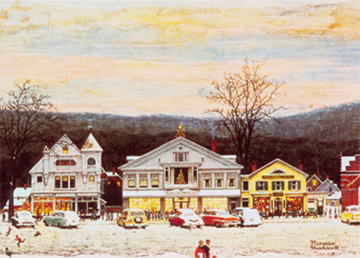
Addendum: Miscellaneous pictures, papers and videos
|
 |
|
Norman had my dad and I pose like this. This is the closest I ever came to being in a Norman Rockwell painting. He did tell my parents that I was the best behaved child he ever worked with so that's something. |
On Using Photographs, from Norman Rockwell, My Life as an Illustrator: "At first I used photographs only occasionally, trying to hang onto at least the shreds of self-respect. But it was like taking a touch of morphine now and then. Pretty soon, before I knew it, I was an addict. A guilty, shamefaced addict, but an addict nevertheless. Because photographs cleared up all my difficulties immediately. I could get the new, weird angles. I no longer had to depend on the professional models. Now anybody could pose for me. Nowadays I use photographs for all my work. I still feel guilty about it. Whenever somebody comes into the studio I slip the photographs into a drawer. But I comfort myself with the thought that many of the great painters used aids to drawing: the camera obscura, the camera lucida, mirrors, et cetera. Holbein had a system for drawing on glass. Albrecht Dürer invented and presumably used a drawing aid. Toulouse-Lautrec and Degas worked from photographs sometimes. These men used the camera and the various other devices as aids, never slavishly. I think I do the same. I don't copy photographs. Lots of people have the idea that when you work from a photograph you just tint it. If that were so, anybody could paint a Post cover, Which they manifestly cannot. I use on an average of a hundred photographs for a single Post cover. They are guides, nothing more. The essential ingredient in every one of my finished paintings is me—my feelings, ideas, skills. Photographs, I repeat, are only aids. After all I did paint directly from the model for over twenty-five years. and I have continued to draw from models; for instance, for the past three years I have attended a sketch class every Tuesday at Peggy Best's studio here in Stockbridge, Massachusetts. Working from photographs has many advantages. Take models, for instance. Now, if I want a bank president, why, I call up a bank president and ask him to come over to the studio for an hour or two. Before, I had to fake it, putting Pop Fredericks in a wing collar and business suit, trying to make him look like a bank president, which he didn't. Now I can get the real thing. ... And settings. there were details, accidents of light which I'd missed when I'd been able to make only a quick sketches of a setting. ... And costumes. I don't have to be so particular about the clothes the model is wearing. ... And expression. I work with a model (I never take the photographs) and when the smile has widened and the eyebrows are way up and the eyes are sparkling, the photographer snaps the picture and I have it. ... " (pp. 291 & 292.) |
 English countryside. |
|
|
|
Blackie Kronfeld died in a Pan Am plane crash in the early 60's. My father bought his photographic lab from his widow and changed careers to photography. In 1977, at the age 83, Norman Rockwell received the nation's highest civilian honor, the Presidential Medal of Freedom, for "vivid and affectionate portraits of our country." He died a year later. About twenty years after Norman, my dad passed on as well. |
 |
 |
 |
 |
 |
|
|
Around the World with Norman Rockwell
promotional video, parts I and II
Norman Rockwell Museum
And last but not least, a Pan Am bag with Norman |
 If you're wondering what I looked like because the two pictures above are profiles, here I am about a year or so before those photos were taken. Wm |
An anecdote: My mom and dad were invited up to dinner at the Rockwell's in Stockbridge, Mass. My dad told Norman they couldn't make it because his in-laws were in town. Norman said bring them along. So they all drove up to Stockbridge together. My dad introduced my grandfather (Al Cox) to Mr. Rockwell, saying, "Norm, this is my father-in-law, Al. Al this is Norm." They got along great but my grandfather had no idea who Norman Rockwell was. It's important to note here that my granddad, before he became a dairy farmer, sold Sherwin Williams paint. In fact, he got some kind of of award for selling over 100,000 gallons. Anyway, after a while, Norm says to my granddad, "C' mon Al, let's go for a walk." So they take a walk in beautiful Stockbridge and arrive downtown shortly thereafter. Norman points to a quaint building in the middle of town and says, "I painted that General Store." My grandfather said to him, "Did you use Sherwin Williams paint?" True story. My grandfather never did find out who Norman Rockwell was until he got back to his home in Minnesota. He laughed about it for days afterwards. William |
|
© William C. House
Print pages in PDF format:
• Part One: Intro
• Part Two: Europe
• Part Three: Middle East
• Part Four: Asia
• Part Five: Hawaii
• Part Six: Conclusion
• Part Seven: AddendumReturn to Page One
Main Page: Reverse Spins









